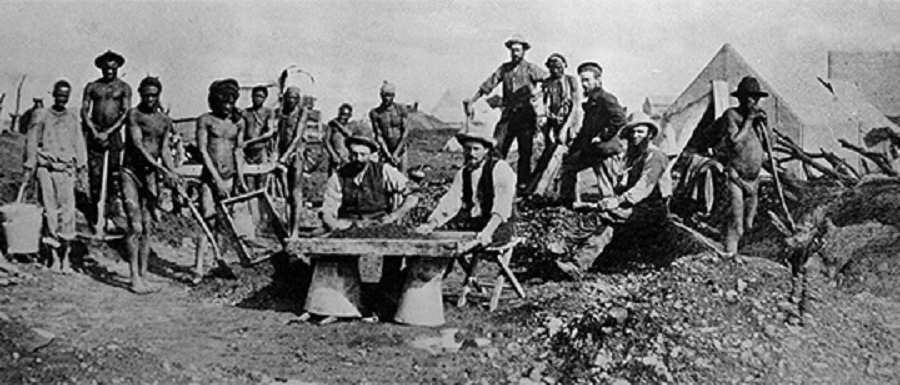Everything in the form of a carriage, from a chaise to a buck wagon, was pressed into service, but the best available transport was the big trekking ox-wagon of the Boer pioneer.
Continuing Diamonds Discovered in South Africa,
our selection from The Diamond Mines of South Africa by Gardner F. Williams published in 1902. The selection is presented in eight easy 5-minute installments. For works benefiting from the latest research see the “More information” section at the bottom of these pages.
Previously in Diamonds Discovered in South Africa.
Time: 1867
Place: Orange River, South Africa

Then a motley throng of fortune-hunters began to pour into the valley of the Vaal. The first comers were those living nearest to the new diamond-field-farmers and tradesmen from the cattle ranges and little towns of the Orange Free State. Some of these were Boers, drawn to the fields as to a novel and curious spectacle, but disdaining the drudgery of shoveling and washing from morning till night for the chance of a tiny bright stone. They stared for a while at the laboring diamond-seekers, and then turned their backs on the field contemptuously, and rode home sneering at the mania that was dragging its victims hundreds of miles, over sun-cracked and dusty karroos, to hunt for white pebbles in a river-bed. Still there were many poor farmers who caught the infectious diamond-fever at sight of the open field and a few sparkling stones, and they camped at Klip-drift or went on farther up or down the river, to join, as well as they knew how, in the search for diamonds.
Following this influx from the Free State came swarming in men of every class and condition from the southern English Colony and from the ships lying in the coast ports. The larger number were of English descent, but many were Dutch, and hardly a nation in Europe was unrepresented. Black grandsons of Guinea-coast slaves and natives of every dusky shade streaked the show of white faces. Butchers, bakers, sailors, tailors, lawyers, blacksmiths, masons, doctors, farmers, carpenters, clerks, gamblers, sextons, laborers, loafers -— men of every pursuit and profession, jumbled together in queerer association than the comrades in the march to Finchley — fell into line in a straggling procession to the diamond-fields. Army officers begged furloughs to join the motley troops, schoolboys ran away from school, and women even of good families could not be held back from joining their husbands and brothers in the long and wearisome journey to the banks of the Vaal.
There was the oddest medley of dress and equipment : shirts of woolen-blue, brown, gray, and red — and of linen and cotton — white, colored, checked, and striped ; trim jackets, cord riding breeches, and laced leggings and “hand-me-downs” from the cheapest ready-made-clothing shops; the yellow oilskins and rubber boots of the sailor; the coarse brown corduroy and can vas suits, and long-legged stiff leather boots of the miner; the ragged, greasy hats, tattered trousers or loin-cloths of the native tribesmen; jaunty cloth caps, broad-brimmed felt, battered straw, garish handkerchiefs twisted close to the roots of stiff black crowns, or tufts of bright feathers stuck in a wiry mat of curls; such a higgledy-piggledy as could only be massed in a rush from African coast towns and native kraals to a field of unknown requirements, in a land whose climate swung daily between a scorch and a chill, where men in the same hour were smothered in dust and drenched in a torrent.
It is doubtful whether a single one of this fever-stricken company ever had seen a diamond-field or had had the slightest experience in rough-diamond winning, but no chilling doubt of themselves or their luck restrained them from rushing to their fancied Golconda. Their ideal field was much nearer a mirror of the valley of Sindbad than the actual African river-bank, and it was certain that many would be as bitterly disappointed by the rugged stretch of gravel at Klip-drift as the gay Portuguese cavaliers were at the sight of the Manica gold-placers.
Everything in the form of a carriage, from a chaise to a buck wagon, was pressed into service, but the best available transport was the big trekking ox-wagon of the Boer pioneer. This was a heavily framed, low-hung wagon, about twenty feet long and five and a half feet broad. In this conveyance more than a dozen men often packed themselves and their camping outfit and food. An exceptionally well-equipped party carried bacon, potatoes, onions, tea, coffee, sugar, condensed milk, flour, biscuits, dried pease, rice, raisins, pickles, and Cape brandy. The total weight of load allowed, including the living freight, was limited to seven thousand pounds.
East London, the nearest port, was more than four hundred miles from the diamond-field, and Cape Town nearly seven hundred. Durber, Port Alfred, and Port Elizabeth were almost equally distant, as the crow flies, approximately four hundred fifty miles but the length of the journey to the Vaal could not be measured by any bare comparison of air-line distances. The roads, at best, were rough trampled tracks, changing after a rainfall to beds of mire. Their tortuous courses rambled from settlement to settlement, or from one farmhouse to another, over the veld, and often were wholly lost in the shifting sands of the karroo. It was a tedious and difficult journey by land even from one seacoast town to another, and fifty miles from the coast the traveler was fortunate if his way was marked by even a cattle path.
| <—Previous | Master List | Next—> |
More information here and here, and below.
We want to take this site to the next level but we need money to do that. Please contribute directly by signing up at https://www.patreon.com/history
Leave a Reply
You must be logged in to post a comment.